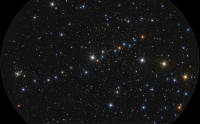Our imaging object for this month was discovered as recently as 1980 – yes you read that correctly – this cascade of stars was first listed by Lucian J Kemble in 1980! Living in Alberta, Canada, Kemble came across this cascade of stars whilst observing in Camelopardalis with a pair of 7 x 50 binoculars. Kemble wrote about his discovery to Walter Scott Houston at the Sky & Telescope magazine and Houston wrote about the discovery and named it Kemble’s Cascade – the name stuck. There is an added bonus with Kemble’s Cascade, at the end of this string of stars is a beautiful little open cluster – NGC 1502 – which greatly adds to the “sparkle” of images taken in this region. Kemble’s Cascade is BIG – you need a short focal length imager to get the whole thing in the field of view – I struggled to get the whole asterism in the Sky 90 diagonal where the FOV is 3.33 x 2.22 degrees – so the Cascade plus the cluster extends to over 3 degrees, which is pretty big.
Usual formula for star pictures, shortish subs, around 3-4 minutes at f#3.5 and as many of them as you can get. For a smooth image you need at least 50 subs so we are talking about a total exposure time around 3 and a half to 4 hours, which is typical for a bright deep-sky object.
So there you have it, a deep-sky asterism discovered and named as late as 1980 – it shows you what can be done! At this point I would like to put in my claim in for Greg’s Charm Bracelet. Greg’s Charm Bracelet is a huge loop of stars that has the Double-Cluster hanging like a sparkly charm from the South East end of the bracelet. What is strange about the bracelet (and this probably goes for Kemble’s Cascade as well) is that it leaps out at you in either binoculars or a low magnification telescope – but you can hardly make it out on star maps or planetarium programs. I am not sure why the eye-brain combination makes the stars in the bracelet stand out so strongly when clearly they aren’t all that much brighter than many of the surrounding stars. Anyway – enough of Charm Bracelet’s – Kemble’s Cascade is the imaging object for this month, and the image below got Noel and me an APOD as well, so the NASA guys like this object too.
Until March 2011 – clear skies to you all!



Hi Greg, that’s an absolutely stunning image of the Cascade. It really is a beautiful asterism. Just one point of clarification. Reading the original Deep-Sky Wonders column of December 1980, in Sky & Telescope, it states that Kemble first came across the asterism whilst sweeping Camelopardalis with a 7×35 binocular, rather than a 7×50. His accompanying sketch is equally impressive, in terms of the detail that he could see with that instrument.
Thank you for the correction re the binoculars 🙂 They were indeed 7 x 35 – I transcribed it incorrectly from “Deep-Sky Wonders” by Walter Scott Houston (edited by Stephen James O’Meara). Glad you like the image, it has created a lot of interest, probably more than any other of my star/cluster shots.